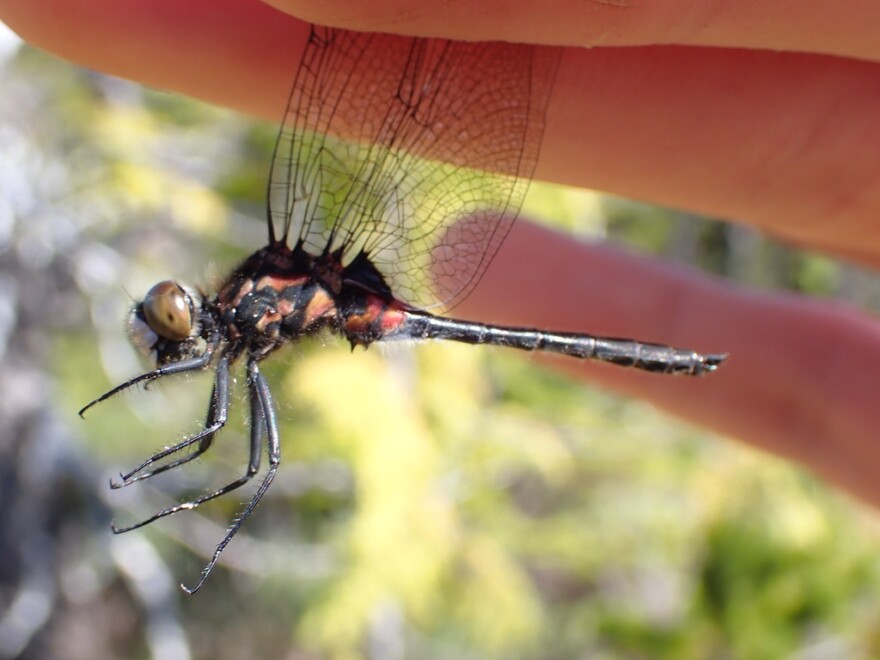John was under the weather last week, so he couldn't get out for his usual phenology walks. However, he's got years of experience and knowledge tucked away for a rainy day like this one; we won't starve for information.
He begins with the ebony jewelwing and river jewelwing damselflies. The ebony jewelwing has all-black wings, while the river jewelweed has half-black, half-transparent amber-colored wings. In contrast to their showy wings, the damselflies' bodies don't look like much when they're flying; if you catch one, however, you'll see a gorgeous iridescent coloring that changes from metallic green to metallic blue, and all the tones in between. Definitely worth finding! John recommends looking for them along rivers and streams; they require moving water.

Though their wings make them easy to spot, there are a few other ways to distinguish them. Unlike dragonflies, whose flight is very fast and direct, damselflies flutter around in a less-directed, seemingly-random manner (partly because they can be easily blown around by a passing breeze!).
While chasing around the jewelwings, you're likely to flush up some other damselflies (and some dragonflies). If you're planning to capture them, John suggests using a net! Once they're captured, take your index and middle finger, make a scissors shape, stick the four wings between them, and pinch your fingers together. Using your thumb and forefinger (as if you were picking up a pencil or piece of paper), you're likely to move them in opposite directions- that can do a lot of damage to those very fragile wings! Pinching all four wings between your pointer and middle finger also makes it easier to pass the dragonfly to someone else- they just make a scissor shape with their fingers and clamp the wings above or below your fingers. Once you're done, just open up your 'scissors,' and off they go!

While you're out there pursuing damselflies and dragonflies, keep an eye out for blueberries and juneberries. Both are ripening right now, though you'll have to compete for the juneberries with the birds! Since juneberries ripen only a few berries at a time, it's easy for birds to strip them clean. John has protected his juneberry shrubs with poultry netting. Those hungry birds have also been feasting on the red elderberries. They're welcome to them, since we can't eat them without making a quick trip to the bathroom!
Fireweed began to bloom this week, eight days later than typical. (John spotted it first on July 7th, while the average date for the first flower is June 29th.) John says, "We continue to be late on a lot of these plants, and you are just going to have to bear with them. They'll get their things done!" [Same, plants, same.] The basswoods typically flower around July 8th and were 5-6 days late this year. The mountain maple has finished flowering but has not yet developed noticeable seeds. The mountain maple is a shrub; it has a similar leaf and seed shape to the more familiar maple trees but doesn't grow as tall. The silver and red maple trees have already dropped their seeds, but the sugar maples are still hung with green seeds. (Maple seeds are the ones with wings that float down like helicopters! They're often called whirligigs, though the technical name is samaras.) This is part of the regular schedule for sugar maples, which always hold onto their seeds this long!

Here's John's update on what's blooming:
- Budding but not flowering: early goldenrod, tansy
- Blooming: Swamp milkweed (Grand Rapids area), pointed-leaf tick-trefoil (a three-foot tall plant with a lot of little pink flowers: Twin Cities area), rabbit's foot clover
- Finished flowering: Swamp milkweed (Elk River area)
The smooth sumacs have finished flowering, and the berries are beginning to turn red. If you lick one, it'll taste sour; bring a few home with you, put them in cheesecloth or an old T-shirt, and stick them in a pot of boiling water to make sumac-ade (add sugar to taste)! The staghorn sumac is in peak flower, much later than usual. John points out that we still feel the effects of the unseasonably cold spring, which has delayed phenological events even months later!
That does it for this week; John is looking forward to feeling better next week and returning to his regular phenology walks! In the meantime, we're all sending him the best of wishes.






